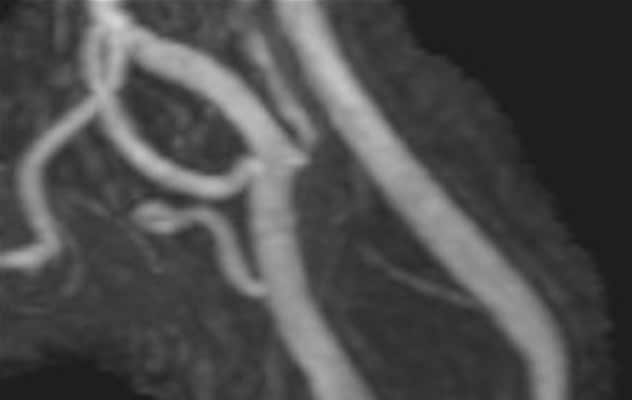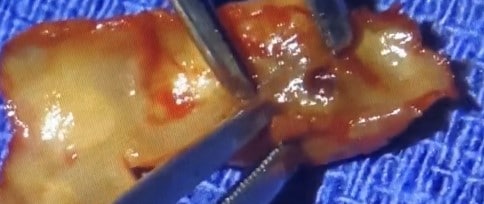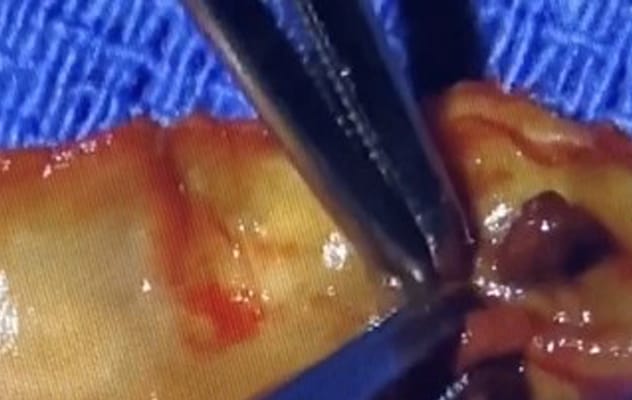July 21, 2021
Mayo Clinic uses state-of-the-art carotid plaque imaging to assess an individual's risk of stroke. Mayo's robust MRI protocols facilitate the detection of specific carotid plaque components associated with ischemic events, even in patients with minimal luminal stenosis.
"Not all plaques are alike. Carotid plaque imaging can help us determine — without invasive surgery — whether a patient's plaque is high risk or relatively stable and low risk," says John C. Benson, M.D., a neuroradiologist at Mayo Clinic in Rochester, Minnesota.
For 80 years, luminal stenosis of the carotid artery has been the primary prognosticator of ischemic events. Since the 1990s, the standard threshold for intervention has been 50% stenosis.
لويحة الشريان السباتي بدون تضيّق

لويحة الشريان السباتي بدون تضيّق
يظهر تصوير الأوعية بالرنين المغنطيسي تشعب الشريان السباتي بدون وجود تضيّق ملحوظ. ويظهر نزيف كبير داخل اللويحة على الجانب الأيسر.
لويحة مُتقرِّحة

لويحة مُتقرِّحة
تُظهر العينة الجراحية لويحة مُتقرِّحة على سطح الشريان بين فكّي الملقط.
الورم الدموي داخل اللويحة

الورم الدموي داخل اللويحة
يؤدي الضغط الخفيف على اللويحة المتقرحة إلى ورم دموي داخل اللويحة يبرز عبر التقرح إلى داخل التجويف الشرياني.
But over the past decade, attention has turned to patients with mild or moderate carotid stenosis who nonetheless have strokes. As a result, interest in various carotid plaque components, including carotid intraplaque hemorrhage (IPH), has grown.
"The presence of IPH — regardless of the degree of stenosis — is in itself a destabilizing factor," says Giuseppe Lanzino, M.D., a neurosurgeon at Mayo Clinic's campus in Minnesota. "Knowing whether a patient has a biomarker of plaque vulnerability allows us to select the patients that are most likely to benefit from intervention, such as stenting or carotid endarterectomy."
A Mayo Clinic study, published in the April 2021 issue of the American Journal of Neuroradiology, found that intraplaque hemorrhage is independently associated with ischemic events in carotid arteries with less than 30% stenosis. An earlier study — published in the February 2021 issue of JACC: Cardiovascular Imaging — reported a higher rate of recurrent stroke in patients who had embolic stroke of undetermined source (ESUS) with associated IPH compared with patients with ESUS with no associated IPH.
'Like a microscopic view of plaque composition'
Approximately 25% of individuals who have strokes have a diagnosis of cryptogenic stroke after full medical workup. Computerized tomography angiography (CTA), a standard component of acute stroke imaging, has significant limitations.
"CTA can show the degree of carotid stenosis and provide some sense of the nature of the plaque. But CTA can't differentiate the lipid-rich necrotic core from the superimposed hemorrhage that sometimes exists," Dr. Benson says.
Mayo Clinic uses magnetization prepared rapid acquisition gradient echo (MPRAGE) to perform carotid plaque imaging. This level of technology, and the expertise needed to analyze MPRAGE imaging, contribute to Mayo Clinic's successful use of carotid plaque imaging.
"It's almost like having a microscopic view of the plaque composition," says Michelle P. Lin, M.D., M.P.H., a vascular neurologist at Mayo Clinic in Jacksonville, Florida. "More often than not, carotid plaque imaging confirms our clinical suspicion that a patient has unstable plaque."
By helping to identify the root cause of a stroke, carotid plaque imaging can prevent unnecessary and frequently unrevealing diagnostic tests. Identifying stroke etiology also guides the clinical team to the optimal treatment for each patient.
"Patients with a diagnosis of cryptogenic stroke might just be given aspirin. But if we know the stroke is caused by unstable carotid plaque, then we might prescribe a higher intensity anti-thrombotic regimen for plaque stabilization, or even referral to our surgical colleagues for revascularization," Dr. Lin says. "As a diagnostic tool, carotid plaque imaging brings a lot of value to patient care."
For more information
Larson AS, et al. Carotid intraplaque hemorrhage and stenosis: At what stage of plaque progression does intraplaque hemorrhage occur, and when is it most likely to be associated with symptoms? American Journal of Neuroradiology. 2021;42:1285.
Larson AS, et al. Embolic stroke of undetermined source: The association with carotid intraplaque hemorrhage. JACC: Cardiovascular Imaging. 2021;14:506.
Refer a patient to Mayo Clinic.